The Catahoula leopard dog is a medium-large herding dog from Louisiana, USA. Catahoula leopard dogs are also commonly referred to as Catahoula leopard hounds, Catahoula curs, Catahoula hog dogs, and Catahoulas.
Catahoula leopard dogs are 20 to 26 inches tall and weigh between 50 and 90 pounds. These dogs are protective, friendly, loving, wary of strangers, and ideally suited to confident owners with experience looking after independent, stubborn dogs. On average, Catahoula leopard dogs live for up to 14 years. Catahoula leopard dogs typically cost $600 to $900.
TABLE OF CONTENTS
Catahoula Leopard Dog Characteristics & Overview
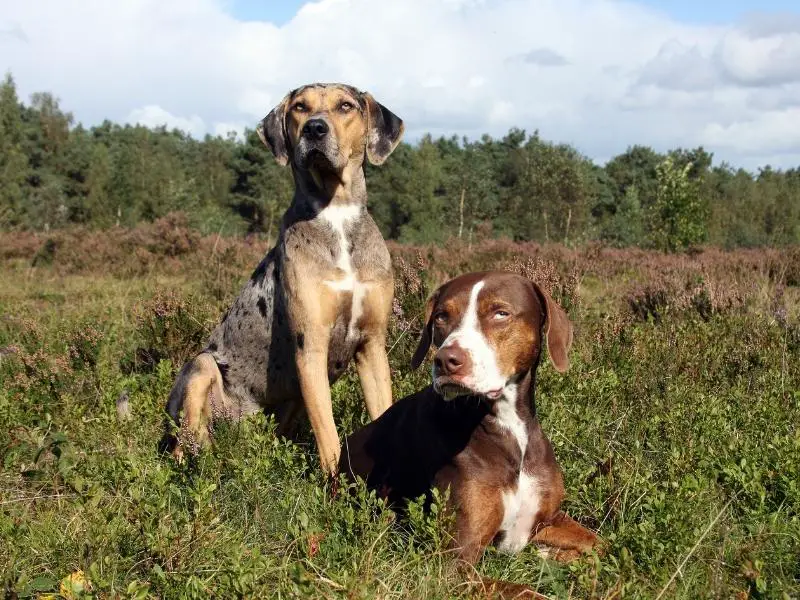
| Common names: | Catahoula leopard dog, Catahoula leopard hound, Catahoula cur, Catahoula hog dog, Catahoula |
| Origin: | Louisiana |
| Breed group: | Herding dog |
| Size: | Medium-large |
| Height: | 20–26 inches |
| Weight: | 50–90 pounds |
| Colors: | Black, brindle, black merle, red merle, yellow merle, silver, brown, white |
| Coat: | Single coat, short or medium length |
| Life expectancy: | 10–14 years |
| Temperament: | Loyal, friendly, protective, independent, wary of strangers |
| Shedding: | Light shedder |
| Barking tendency: | Occasionally, to alert its owner to potential intruders |
| Cost: | $600–$900 |
Origin & Purpose
The Catahoula leopard dog originated in Louisiana near Catahoula Lake in the 1700s. The breed is thought to have been introduced to the state by French settlers who bred their beauceron dogs with swamp-hunting wolfdogs and used the Catahoula for hunting feral boars. The Catahoula leopard dog became the state dog for Louisiana in 1979. Now, this breed still serves as a hunting companion and is also a popular family pet.
Lifespan
The average lifespan of the Catahoula leopard dog is 10–14 years. The dog’s health status, level of physical activity, diet, and emotional wellbeing contribute to its expected lifespan. Healthy, active dogs are likely to live longer than sedentary, overweight dogs.
Catahoula Leopard Dog Appearance
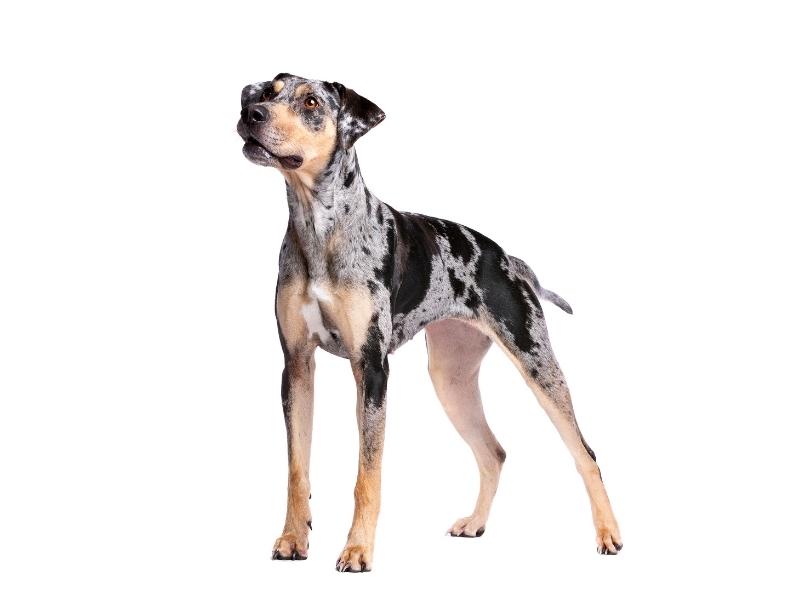
The Catahoula leopard dog has a medium-large body with a muscular, athletic build, a long tail, and a short dense coat.
Height and Weight
Catahoula leopard dogs are considered medium-large dogs, with a height at the withers of 20–26 inches and a weight of 50–90 pounds. Genetics play a role in the size and weight of the dog — a puppy bred from larger-than-average parents will likely also carry these genes.
Colors
The Catahoula leopard dog has a brindled or patched coat with leopard-like spots. The dogs’ coat colors are typically black, brindle, and white. Black merle, red merle, yellow merle, silver, and brown colors are also common in this breed.
Catahoula leopard dogs usually have a solid color with spots on their backs and patches of other colors, such as tan or white, on their chests, faces, or legs.
Coat
Catahoula leopard dogs have dense, short-to-medium coats that are smooth to the touch. The breed’s shedding tendency is low.
Face and Head Shape
The Catahoula leopard dog has a broad, flat head with a wide muzzle that tapers at the nose, and small-to-medium ears that droop at the tips.
This breed is known for its distinctive eye colors. The dog’s medium-sized, rounded eyes are blue, green, amber, brown, or a combination of these colors.
Catahoula Leopard Dog Personality and Temperament
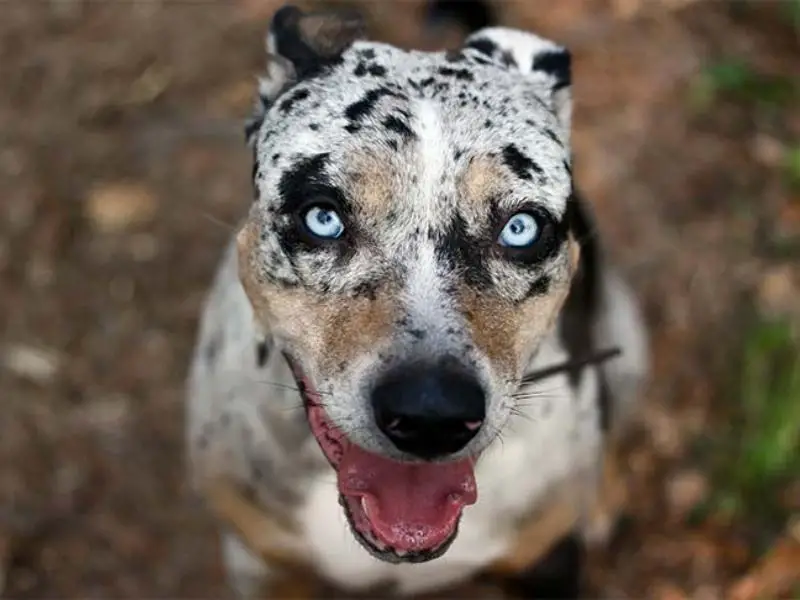
The Catahoula leopard dog is a loyal, protective, playful family dog with an instinctive wariness of strangers. This dog is friendly, affectionate, and focused when working in the field.
The Catahoula leopard dog has an independent streak and strong chasing instincts and is known to be dominant towards other dogs, so this breed is best suited to families with no other pets.
Barking
Catahoula leopard dogs have low barking tendencies, although they’re natural watchdogs and bark occasionally if they sense danger. This breed may also bark if left alone for long periods.
Catahoula Leopard Dog Care
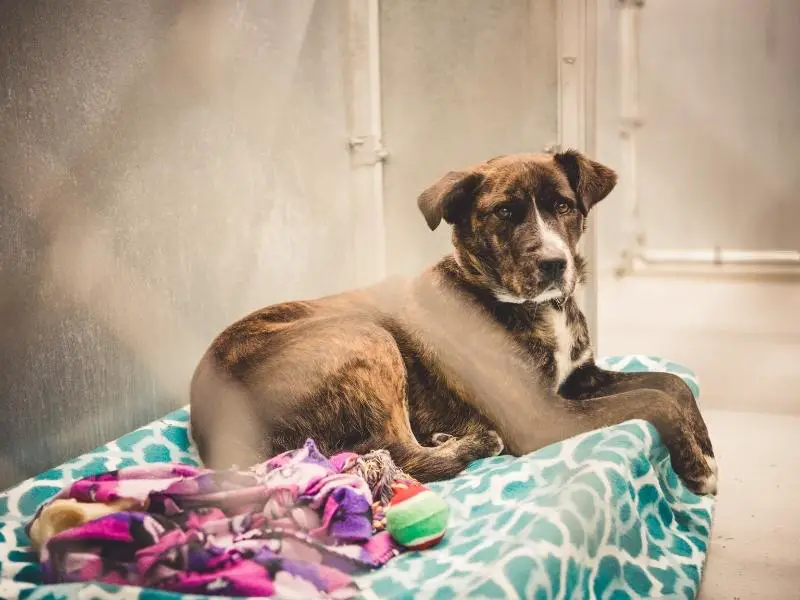
Caring for a Catahoula leopard dog is easy, but this confident, assertive breed isn’t recommended for a first-time owner. Experienced dog owners enjoy raising, training, and looking after a dog of this breed.
Food Needs
Catahoula leopard dogs have moderate to large appetites and need about 1,200 calories, or three cups of kibble, per day, split into two or three portions. The dogs are active and burn a lot of energy, so they need high-quality food that supports their daily activities. The age, size, and activity level of the dog affect its food requirements.
Grooming Needs
Catahoula leopard dogs have short fur, so their grooming needs are minimal and professional grooming isn’t required. The dogs shed seasonally and should be brushed once a week with a soft brush or a rubber mitten. Brush your dog’s teeth once a day and clip its toenails when they grow long enough to click on the floor.
Exercise Needs
Catahoula leopard dogs were bred to herd and hunt, so they’re used to leading active, outdoorsy lifestyles and require at least one hour of exercise per day. Walking, running, hiking, swimming, and vigorous playtime are all good ways to keep this dog fit and healthy.
When these dogs don’t receive enough exercise they’re known to become mischievous and aggressive, so it’s essential to meet their exercise needs regularly. Catahoula leopard dogs are ideally suited for active people in homes with backyards, and they’re not good apartment dogs.
Mental Needs
The Catahoula leopard dog needs at least 45 minutes of daily mental stimulation in the form of playtime, training, bonding, and socialization.
This intelligent breed enjoys dog sports, like agility and rally, and games that are physically and mentally challenging, like treasure hunts and hide-and-seek. Use puzzle toys and treat release toys to keep your dog entertained while you’re too busy to play.
Common Health Concerns
Catahoula leopard dogs are prone to several common health conditions.
Hypothyroidism: Occurs when the body doesn’t produce enough of the thyroid hormone. Dogs with this condition may have a dry coat and skin, gain weight, and become aggressive and fearful. Veterinarians test dogs for hypothyroidism and provide thyroid replacement hormones in tablet form to treat the condition.
Eye problems, blindness: White Catahoula leopard dogs are especially prone to eye problems that lead to blindness. Common causes of blindness are cataracts, progressive retinal atrophy, and glaucoma. Blindness in dogs can sometimes be prevented by treating the cause of the eye problem. A veterinarian can examine the affected dog and discuss potential treatments and preventative actions.
To reduce the risk of health conditions in a Catahoula leopard dog, buy a puppy from a reputable breeder and enquire about health checks that the parent dogs have had.
Catahoula Leopard Dog Training
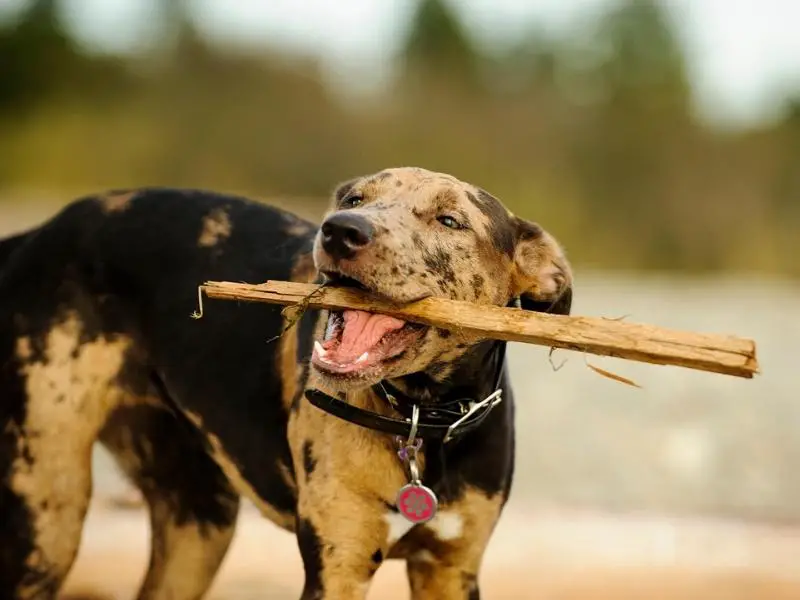
Catahoula leopard dogs are intelligent but independent and headstrong, and they’re not as obedient and eager to please as other breeds. Persistent, reward-based training is essential to encouraging obedient behavior in this dog from a young age.
The Catahoula leopard dog can be trained from the age of two months old. Begin by teaching the dog basic commands, toilet training, and leash training the dog. Socialize the puppy in a variety of environments and with different people and dogs.
If you struggle to train your dog, consider a professional trainer, who can help you to assert dominance and make fast progress with training.
Catahoula Leopard Dog Price
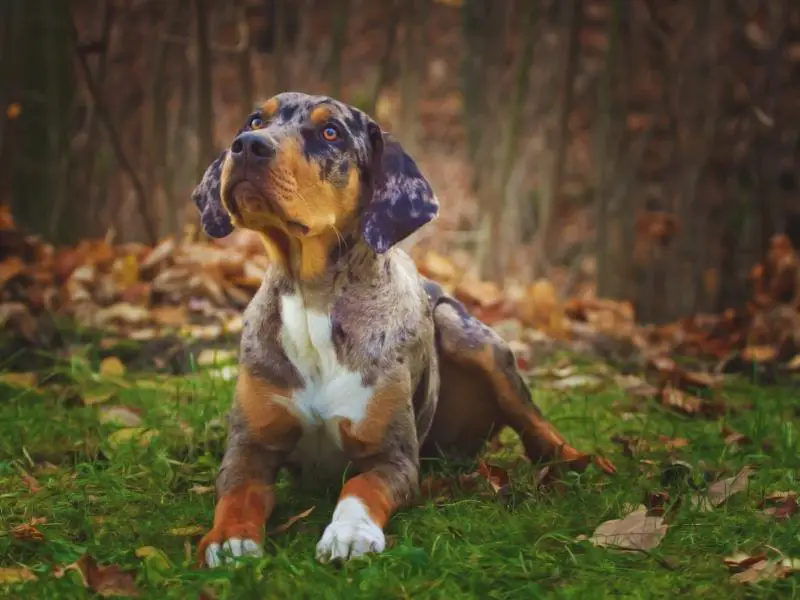
Catahoula leopard dogs are priced as mid-range dogs. Adopting a dog is cheaper than buying a puppy, but the Catahoula leopard dog breed is rare and the dogs aren’t commonly found in pet shelters.
How Much Is a Catahoula Leopard Dog?
A Catahoula leopard dog typically costs $600 to $900. The price of the dog depends on factors including:
- Age: Puppies are about $500 more expensive than adults
- Color and markings: Dogs with uniquely-colored or patterned coats are more expensive than dogs with common coat colors
- Breed status: Dogs with a pedigree status are expensive due to the time invested into maintaining the dog’s bloodline
- Whether you buy or adopt the dog: Adoption fees are usually about $200
How Much Does it Cost to Own a Catahoula Leopard Dog?
After the initial purchases of bedding, a leash, and other essential supplies, the monthly cost of owning and feeding an energetic, medium-large Catahoula leopard dog is about $70. This cost includes food, toys, training supplies, grooming, healthcare, and optional costs like dogsitting and professional training.
Is a Catahoula Leopard Dog Right for You?
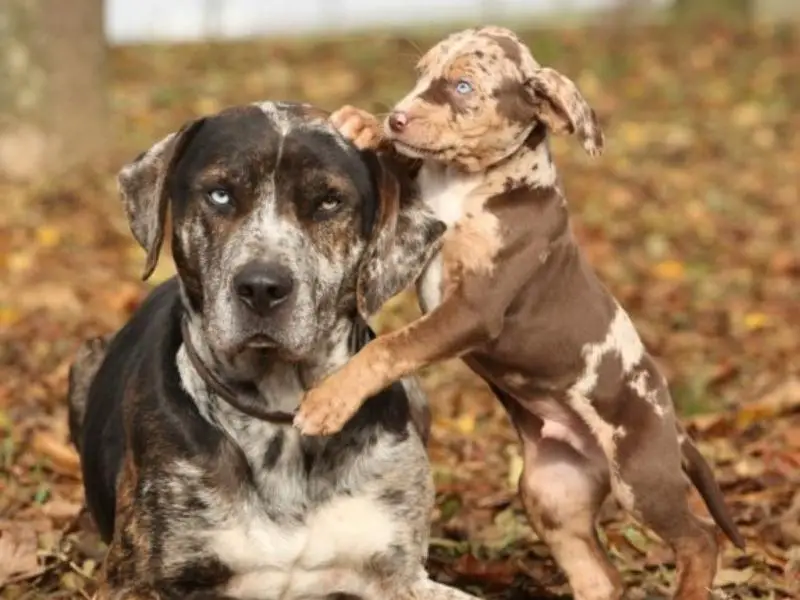
The Catahoula leopard dog is a loyal, beautiful breed, but it may not be suitable for some people or lifestyles.
Catahoula Leopard Dogs Are Suitable for:
Catahoula leopard dogs are active, intelligent working dogs that thrive on attention and outdoor exploration, so they’re best suited to people who have the time and energy to train, play with, and exercise their pets.
The dogs prefer to be the only pet in the household, so they’re good for families that don’t already own a pet. Catahoulas have a lot of energy to burn, so they do best in a home with a backyard that can be accessed at any time in the day.
Confident, experienced owners with no children or who have older children enjoy the challenge of looking after a Catahoula leopard dog.
Catahoula Leopard Dogs Are NOT Suitable for:
Catahoula leopard dogs need a lot of mental stimulation and exercise, so they’re not suitable for inactive people or people who don’t have the time or patience for a demanding pet, and they’re not good apartment dogs.
The dogs have a high prey drive, so they’re not ideal for households with small children or other pets. First-time dog owners might struggle to look after this breed and should consider a different, similarly-sized breed that’s less demanding than the Catahoula leopard dog, such as a labrador retriever or a boxer.


Be the first to comment